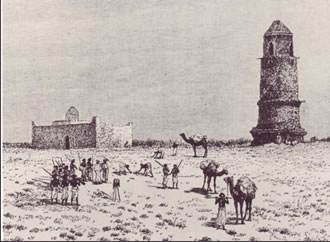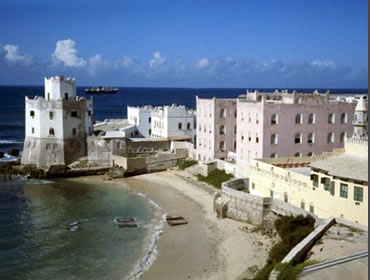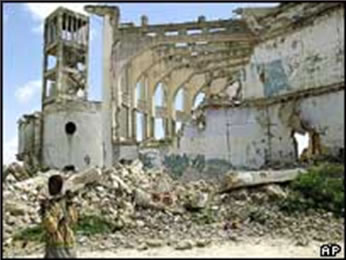by Muuse Yuusuf
Call it Muqdisho or Xamar; pronounced it as مقديش Maqadīsh, Mogadishu, Mogadiscio in accordance with different pronunciations in different languages in Arabic, Italian, English, Persian and Somali, the city is the biggest in Somalia and officially the capital. The origins of the name Mogadishu is contested; some historians claim that it is the Somalis-ed version of the word "maqad shah" (imperial seat of the shah), which is either Arabic or Persian name or a mixture of both languages. The origins of Xamar, the popular name, is also disputed by historians; some say the word Xamar was coined from the Arabic word for red "الحمراء” translated as “the red one” while others say the name Xamar was coined from the حِمْيَر،” - the name of a government that ruled Yemen before Islam, which controlled coastal towns in East Africa including Xamar.1
As there are question marks over the origins of its name, so is the century in which the city was found. Some historians believe that the city was found c7 or 8c AD. Who founded the city is also disputed by the historians; some tend to assert that Arab migrants created the city, i.e. the city was a settlement for Arab migrants who either visited East Africa’s seashores, spreading Islam, or were there before Islam in pursuit of commercial interests.
For centuries the city has been one of the greatest cities in the world as a seat of civilisation and an important trade route between Africa and the rest of the world. Archaeological materials such as cloths from India, Chinese porcelain, and coins from Ceylon (Sri Lanka) and Annam (Vietnam), and China prove that. Also, some of the city’s architecture and buildings such the Xamar Weyne mosque built around 1252 AD, the Abdul Aziz Mosque, the Arbaca Rukun mosque – built around 1252 AD, and the National Museum building, which was once the administrative seat of the Sultan Barqash’s government, are all evidence of city’s rich history. 2
Ibn-Batuta, the great Arab explorer visited the city in around 1331 AD, describing it as a great city where he met religious scholars and leaders.
 |
| Figure 1: Historical Mogadishu – Abdul-Aziz Mosque in 1800s |
The traveller was impressed by the abundance of food in the city, describing some of its residents as fat and corpulent where a single person would eat as much as a group of people would eat! Portuguese, spearheaded by their great explorer Vasco Da Gama, visited the city but did not succeed in taking it. Sultan Bargash, the sultan of Zanzibar, occupied the city in 1871. A famous architectural evidence of the sultan’s control over the city is the Mogadishu’s museum, which was once the seat of the local administrator.
During the colonial era, Mogadishu attracted the then superpowers’ attention. Italians took the city over when they bought it from the Sultan of Zanzibar in 1905. Italians made the city the capital of the Italian Somaliland. This was followed by the British who conquered the city in 1941. However British rule ended when Italians seized the city again in 1952 to administer the Italian protectorate under the UN mandate, which was meant to help Somalia toward independence.3 Finally in 1960 the city came under the control of a Somali government that was independent from its colonial masters and since then as the capital city of modern Somali state until the collapse of the state in 1991.
During the height of the civil war in early 1993, Americans tried to subdue the city but failed and lost it to the late General Aidid’ forces, and since December last year Ethiopians are trying to assert their authority over the city against insurgency forces.
Now some of my readers would ask themselves this question: why this writer is boring us telling a brief history of Xamar, a ghost city; a city of death, destruction, rape and pillage; a city that has lost its glory, pride and place in the eyes of Somalis. My answer to that question is simple. I believe that there is a Mogadishu factor in the Somali conflict which needs to be understood, analysed, and resolved as part and parcel of national reconciliation. Also, I think there is a need to find answers to this question: why the city continues to be the focus of so much destruction and death when other cities enjoy some sort of security and stability? Or as Paul Salopek of the Chicago Tribune put it in an article posted at www.hiiraan.com, why there are so many ways to die in Mogadishu? And what needs to be done to stop the mayhem that keeps on befalling on the city now and again?
Since the independence, like any other capital city in the world, Mogadishu has been the delight of the Somali people. The city has been the country’s political, social and economic power-house for a very long time. In its heyday the city hosted all national institutions such as the parliament, national banks, ministries, academic institutions, as it enjoyed major economic infrastructures like sea and air ports, roads, manufacturing industries. Major political and economic decisions that affected people’s life, for example the decision to go war with neighbour countries; the decision to launch the national literacy campaign and many more important decisions were taken in the city.
And because of its status, throughout the years Somalis from all walks of life have developed strong emotional attachment to the city. It would not be exaggeration if I state that the few Somali elite and middle classes who were lucky enough to get education had received their education in Mogadishu’s academic institutions. As far and remote as Zeylac and Ras Kamboni, Somalis congregated in the city seeking employment, education, wealth, as they heavily invested in it sometimes at the expense of the cities in their homelands. Anyone who could afford had bought house or a plot of land. Those of us who lived in Mogadishu at the time can still remember the huge scramble for land grabbing that existed in the city, how you were considered to be wealthy if you owned property in Mogadishu, and how the city sprawling with people, grew in size and new names such as Huriwa, Xamar Jadiid were added to the names of the city’s old quarters of Xamar Jab-Jab and Xamar Wayne.
In its booming business days, prominent wealthy people like the famous Jirde Hussein from the Northwest region and the Uunlaay brothers had their business
 |
| Figure 2: Mogadishu at its glory days– beautiful beaches |
headquarters in the capital; one only needs to remember the famous Jirde Hussein building opposite the Café Nazionale.
Socially, during its harmonious days, the city was a home for all Somalis regardless of their regional backgrounds or clan affiliation. They lived side by side in peace and harmony. I invite those of you who lived in Mogadishu to join me in remembering how families from different parts of the country had lived in and shared houses, how your neighbour was someone from as far away as Hargeysa, Baydhabo, or Kismayo, and how children played together, went to school together happily, and education was available to them regardless of their background. In its amorous times, lovers kissed and held hands in Mogadishu’s gardens and got married regardless of their clan affiliation. A real metropolitan city it was.
In its peaceful times, Xamar Cadde (the white and sweet Xamar!) was so peaceful that girls and boys would go out to enjoy city’s night life and would stay out as late as 2 a.m. without fear for their safety and security. In a typical weekend, the young folk would go out to play football at the Liido sandy beach, would eat lunch at one of Mogadishu’s many restaurants enjoying muufo iyo maraq, would see movies at city’s cinemas such as the famous Mizzione cinema near the Italian Cathedral, and finally would go clubbing at the Curuubo or Jasira night clubs.
In its happy days and in a ceremonial mood, national festivals like the Prima Luglio - the Independence Day – were held there, and everyone celebrated. Mogadishu’s straight and long streets would have been cleaned and decorated with colourful lights; Mogadishu residents would have decorated their homes to welcome the big day, School children would have chanted national songs and anthems, as military parades would have been held at the Tarabuunka etc.
In its spiritual times, the religious folk such as the culimo, sheiks and xerta would congregate at mosques or open spaces to indulge themselves in the Dikr of Allah in accordance with their Dariiqa or Sufi sects’ teachings whether it is Qadariya, Saalihiya or Ahmadiya etc.
In its playful and sporty times, Mogadishu hosted the country’s regional football and athletic games, and teams from as far as Kismayo and Hargeysa would travel to Mogadishu, and if they were good enough would have returned to their regions as winners with trophies. National sport teams like the famous Horseed and Jeenyo all competed in Mogadishu for national league cups, as major African sport games were held in the city.
Simply put it, Somalis were proud of Mogadishu, their beloved city.
Unfortunately, all the above beautiful memories started to come to an end in late 1980s when the military regime started to hunt and crack down suspected sympathisers of armed opposition groups Somali Salvation Democratic Front (SSDF), Somali National Movement (SNM). Although Mogadishu’s residents sometimes felt the military regime’s repressive measures and no one can deny that, it was not until the United Somali Congress (UCS) forces entered the city in 1991 in order to dislodge the military regime that the city became a place for every thing that is miserable, evil and hurtful. Suddenly, neighbours who once lived in harmony and peace turned against each other; women lot raped, properties looted. National treasures misappropriated. During the height of the civil war the city witnessed some of the worst atrocities when murderous militias motivated by venomous politicians started to root out those communities who they suspected did not belong to the city. Remember, those persecuted communities were people who had lived in the city for centuries for example the Reer Xamars, reer Benadirs, and those from other clans, people who had developed strong emotional attachment to the city throughout centuries and were fond of her; people who enjoyed all the above-mentioned beautiful things in city’s glorious days. Immediately, they had to leave their much loved properties behind their backs powerless, humiliated, broken heart, and driven out of their loved homes. As they were chased out of Mogadishu, the persecuted communities realised that Mogadishu was no their permanent home anymore and that they had to start new lives somewhere, probably in the regions they came from.
The city’s misery did not end by the expulsion of those
 |
| Figure 3: Mogadishu at war – ruins of the old parliament building |
communities, but the bloodshed continued when communities from the same clan family slaughtered each other and the warlord world was created. During the warlord times, the most famous features that city’s residents had to endure were the famous Isbaarooyin which were erected by the infamous Mogadishu warlords to harass, kill, and to extort money from the public. The city was divided into zones controlled by warlords.
In mid 1990s, American forces also caused mayhem in city as they hunted down General Aid. Quite recently Ethiopian forces committed atrocities against its residents. And as you read this article, insurgent and TFG\Ethiopian forces are engaged in deadly game of hit and run where road bombs, political assassination, closing downs markets and media stations are the norm.
Because of the atrocities that took place in Mogadishu, it is in this writer’s opinion that the city has lost its charm, pride, importance in Somalia, that the city cannot and should not be considered as the capital because it has lost the respect of most Somalis, particularly those who once regarded it as a safe haven for all Somalis regardless of their clan affiliation. As it has lost its place and has been associated with so much violence and bloodshed, Somalis have turned their backs to Mogadishu, the city they loved. They have returned to their environs, investing in their cities and towns. If yesterday Somalis were proud to own properties in Mogadishu, the new magic word in the current realities is that most Somalis are much happier to build houses, schools, universities and hospitals in their hinterland. The man from Bosaaso, Hargeysa and Baydhabo are now busy in rebuilding and developing their environs, which they have neglected so long for the sake of Mogadishu. No time for Mogadishu now. As far as they concerned Mogadishu is a ghost and murderous city where mooryaans, warlords, Isbaarooyin, religious fanatics, and now Ethiopian/TFG forces and the insurgency vie for power and dominance.
In the world history, there are some occasions in which the capital city of a country had to be changed for political, social or economic reasons. For example Nigerians have changed their capital city few times and there are many other examples. The TFG’s decision to use Baydhabo as a temporary seat for the government was a brave and important political decision, and in my opinion they should have continued to use Baydhabo or other cities such as Bosaaso or Hargeysa as a seat for the government. In my view, the TFG’s decision to relocate to Mogadishu was a mistake because although people still think Mogadishu as the capital city, this is just on paper not more than that. The metropolitan city has lost its charm, appeal and respect because of what happened and is still happening in the city, and in my view anyone who tries to pacify it in the immediate future will probably do more harm than good. In my opinion the city needs time for healing, time to allow communities to reconcile, and one way of making that possible is if the city is de-politicised: no more Mogadishu as the capital city but just one of the cities in Somalia. That would safe the city and its residents from further violence because if it continue to be called the capital city those rival political groups that vie for power will always be making Mogadishu as their ultimate target because by conquering the city they will be seen as the victorious forces who control the capital, a name that exists on paper only!! Imagine a new round of fighting and military showdown between the insurgence force that are beating the drums of war for the control of Mogadishu and TFG/Ethiopian forces that are entrenched in Mogadishu. There will well be more bloodshed again.
While the city is being de-politicised and becomes just a normal city, a regional or mayoral administration could be established by those who have authority in the city. I would suggest that the existing structure and institutions that the TFG has put in place be developed and maintained but just as an entity to look after the city and its people only and not as federal institutions. This means the TFG accepting that Mogadishu is not a capital city but a city that needs a space and time for healing. This is in the hope of creating an atmosphere in which normality and peace can return to it. This again is in the hope of gradually paving the way for the return of those who fled the city recently and during the civil war to their once loved city in order to reclaim of what is left of their properties. One good example of communities just doing that was when delegates gathered in Mogadishu to attend the recent national reconciliation conference. Prominent figures such as the president of “Puntland” returned to Mogadishu after a long absence.
Even after 17 years of absence from Mogadishu, a lot of Somalis in the Diaspora and inside Somalia talk of their good memories of Mogadishu and properties and wealth that they lost, whispering to each other of how they wish they could return to the city to reclaim their status and position. This may not be possible if the city continues to be a base for power struggle with no end in sight.
In conclusion, I would urge those in power to take a brave political decision to stop referring Mogadishu as the capital city of Somalia but just call it an ordinary city, and the TFG and those in power to continue using other fast growing cities such as Hargeysa, Garowe, Baydhabo etc as a new capital of Somalia until such a time when Somalis decide on which city should be a capital for a negotiated state. Why not give Hargeysa – which has been the second city for a long time – a chance to become the capital of Somalia for the first time? The TFG should continue to keep the parliament in Baydhabo, as it should consider relocating its seat to other cities.
Also, for those – insurgency forces – who are now beating drums of war and who aiming to control Mogadishu, I would urge them to engage in a political dialogue to find solution to our nation endemic conflict. This is in order to avoid more bloodshed in Mogadishu, a wounded and bleeding city. I would also urge the international community to order the entrenched Ethiopian forces to leave the city as soon as possible because their presence would lead more confrontation and violence.
Muuse Yuusuf
[email protected]
Source:
http://www.islamonline.net/arabic/arts/2004/12/article10.shtml http://ar.wikipedia.org/wiki/%D9%85%D9%82%D8%AF%D9%8A%D8%B4%D9%8A%D9%88
http://en.wikipedia.org/wiki/Mogadishu